Abstract
Due to the need and request for a more sophisticated and robust understanding of the area of bondage, discipline and sadomasochism (BDSM or SM) activity, a more detailed and organized visual representation model was developed based not only on clinical experience, but on input from the SM community. This is called the model of action and perceived power (MAPP). After a review of the literature finding that little has been written outlining any adequate pictorial models of these relationships, the MAPP was developed to chart how commonly identified personal or given labels such as Master, Slave, Predator, etc. within the community, fit within a greater context or organizational structure under the umbrella concepts of action activities and perceived power, with some hint at intensity in these areas. This model also identifies interaction styles that complement each other within these concepts, intensity of their style as well as an action to shift roles within this model called the “Tilted Alpha.” Finally, this paper outlines some of the previous models brought forward by others which support the foundation of this current visual model.
Introduction
Many of the historical large-scale survey studies by famous sexual researchers such as Hunt, Kinsey, Pomeroy and Martin, beginning in 1948, almost completely ignored SM behavior (Moser & Kleinplatz, 2006). Even though there is the general historical belief that this behavior is not of common interest, Google searches for BDSM even back in 2011 showed over 27 million web pages being present (Moser & Kleinplatz, 2006). More up-to-date research has indicated that 19% of males in a Canadian sample and 10% of females-rated sadistic scenarios described in their questionnaire as being at least “slightly arousing” (Dawson, Bannerman, & Lalumière, 2014) with up to 10% of the population actually being involved in some form of BDSM activity (Crepault & Couture, 1980). Additional research has also found that most BDSM practitioners are generally emotionally and psychologically well balanced and comfortable with their sexual orientation (Moser & Kleinplatz, 2006). This is also supported by other research indicating that BDSM practitioners also have more favorable psychological characteristics (as measured by the NEO FFI), have higher subjective well-being and are less rejection sensitive (Wismeijer & van Assen, 2013) and are even part of our popular culture (Litman, 1997). These findings ultimately support the idea that there is not only a reasonable healthy interest in this area, but that healthy, well-balanced people are participating in BDSM. BDSM is more common than initially believed supporting the need for more easily understood visual representations of concepts within this area.
As mentioned earlier, this type of interest is prevalent among a relatively large number of people and less deviant than previously believed (Powls & Davies, 2012). These findings, a sincere desire and request from clinicians in the field dealing with sexuality, sex therapists, and these authors 20+ years of clinical experience, generally support the need also for a more sophisticated, robust understanding of these interaction patterns as well as overall SM activity (Moser & Kleinplatz, 2006, 2007; Powls & Davies, 2012). This does not include the many requests over the years from clients (both SM and non-SM practitioners) to easily understand power play and relational dynamics. One way to help with this understanding is to simply and more adequately chart or map how (self) labels can fit within a greater context or organizational structure of power and action play.
What BDSM is
The term BDSM can be summarized into three main clusters. These clusters are bondage and discipline (the act of using restraints both physical and or psychological), domination and submission (taking control while the other gives control over) and sadism or masochism which explores deriving pleasure from the pain of others or self (Hebert & Weaver, 2015). By looking at these definitions closer, two common themes begin to stand out: power play (Power or the psychological component) and physical play or stimulation (an Action component) activities. These activities therefore appear to stand out as being the two main foundations of BDSM play. Through discussion within the BDSM community as well as exploring BDSM websites such as Fetlife, etc., most individuals who are regularly active within the community understand these two concepts and commonly have a particular label or labels for these individual preferences, roles or lifestyles. Although BDSM may include personal, sexual and spiritual identity it can also only include play. For those who are not familiar with this area of sexuality, the two concepts of power play (power exchange play such as bossing someone around, taking on the role of a slave, etc.) and action play (physical stimulation such as whipping, flogging, spanking, etc.) are assigned labels which may be confusing at times (i.e. Topping from the bottom, Service Dom, etc.) especially for someone who is new to BDSM activity or the community.
This problem has led to both taxonomical issues for clarity, as well as recognizing any balance or interactional patterns seen between both the physical and psychological dimensions of BDSM (Moser & Kleinplatz, 2006). There has also been a historical tendency for research to lump BDSM practitioners as a whole group without delineating preferred roles (Hebert & Weaver, 2015) and even the tendency within particular BDSM activities to lump dominants and submissives together without exploring their uniqueness or differences (Hebert & Weaver, 2015). Thus, it can easily be seen how there can be some confusion by those in the community, as well as those not, in regards to titles or labels, self-labelled or given. This is not including the added complexity of how the two concepts, power play and action, intersect and ultimately interact with each other.
This tendency and lack of clarity has led to the development of a newer model of understanding, the model of action and perceived power (MAPP) seen in Figure 1. This model graphically portrays the two concepts of action and power play into an much easier means to understand both BDSM labels, titles and/or activities as well as more general power and action interactions (usually in the so called “bedroom” or playspace). This visual model intends to help better clarify these issues and better organize the labels that are already out there by “tidying up” the current taxonomy. By both clarifying and organizing these labels in this way , it would also better visually frame and identify these labels and concepts into a map like representation, which would both help those in therapeutic practice explain these concepts as well as open up a frame of new options for future research.
Figure 1. MAPP basic model
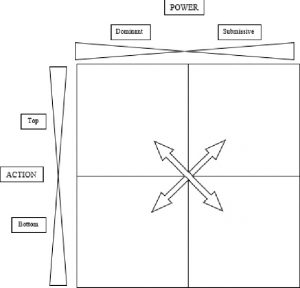
Review strategy
Three databases exploring peer and non-peer reviewed articles (Road Runner, EBSCO Host and ProQuest) were searched using the terms BDSM, theory, model, interaction, dominance, submission and sadomasochism. Although the volume and/or quality of the increasing body of works coming from within the Leather and BDSM communities themselves has increased over the last few decades, and some of these works/texts were explored prior to this article, the primarily search was for dissertations, scholarly and non-scholarly articles. Only those that have been referenced in this article were identified. No date limits were placed within the search items and only articles which were written in English were reviewed. The articles identified from the searches were reviewed for suitability, based on a review of the abstract or the article text. Articles that were included were chosen if they explored some form of theory or outlined some form of pictorial model of understanding, described interaction patterns, or appeared to have relevance to these areas. After a review of the three databases, it was determined that there has been little written outlining descriptive pictorial models of these relationships within BDSM. The closest relevance was identified in Raymonds (2015) model seen in a presentation (see Figure 2), a Venn model within a dissertation research project in 2008 by Busbee (see Figure 3) and Pendal’s (2008) thoughtful but non-academic and unpublished web discussion involving his model describing sexuality involving headspace, physical sensation and aggression (see Figure 4).
Figure 2. MAPP model with common tiles
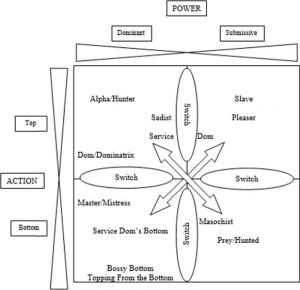
Figure 3. Raymond’s conceptualization
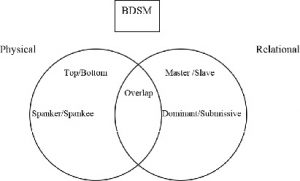
Figure 4. Busbee’s Venn Model
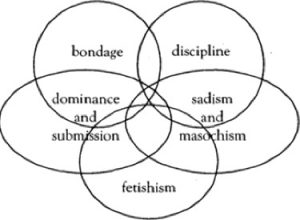
Earlier visual conceptualizations
Authors such as Jack Rinella, Mark Thompson, Joseph Bean, Peter Hennen, Guy Baldwin and more recently Nick Field have been writing about and practicing these concepts of power and action activities for decades. Unfortunately, it has only been as recent as 2008 that Pendal (2008), Busbee (2008) and Raymonds (2015) appear to have visually conceptualized and integrated these BDSM concepts into some form of a visual model. Busbee’s Venn diagram supported the idea that “the elements of bondage, discipline, dominance, submission, sadism, masochism, and fetishism all combine to create an elaborate web of interactional possibilities for practitioners of BDSM” (Busbee, 2008, p. 78). Pendal (2008) plotted his conceptualization through an x, y and z-axes diagram which this author believes was a good start of modelling these concepts in a visual diagram. Pendal (2008) identified his conceptualization as related to headspace, aggression and physical sensation (see Figure 4). Raymond’s (2015) conceptualization explored the BDSM dynamics from a physical and relational component (see Figure 2). This model was not identified until early 2016, at an AASECT conference presented by Susan Wright of the National Coalition for Sexual Freedom. Raymond (2015) identified some form of crossover between some BDSM concepts of physical and relational components (see Figure 2). Unfortunately, these conceptualizations were only an identification of these concepts or a brief discussion of their model and thoughts and were not as well expanded on to allow for notable classification or labelling (if needed) to any depth.
The difference between these models and the MAPP model is that first, concepts such as aggression and fetishism and the labels brought forward from these concepts are very specific forms of action or interest. Second, the Venn diagrams only identify behaviors with some crossover of their commonalities. Third, none of these models talk about any interaction dynamics. For instance, in Raymond’s model, the Top/Bottom-Spanker/Spankee is under the physical realm (action concept according to MAPP) while all of the Master/Slave-Dominant/Submissive titles are relational according to Raymond, which fall under the perceived power concept in the MAPP. Ultimately, the MAPP model allows for more of an open model related to action and power exchange on a continuum grid of giving and receiving and does so in a more precise manner.
Therefore, although much has been written in the area, there is still a noticeable lack of in-depth understanding regarding BDSM, both within the academic community and within the BDSM community (Moser & Kleinplatz, 2006, 2007). This particularly includes the accurate labelling of behavior, based on roles played, taken or lived by or in through a visual and conceptual model. This accurate labelling is important considering that, as mentioned earlier, previous research examining BDSM and their practitioners tends to cluster these as a group and does not delineate their preferred roles or actions (Hebert & Weaver, 2015). Finally, and perhaps more importantly is the lack of an adequate model expressed in a visual representation based on the current understandings surrounding the interactions between the two concepts (power and action play), which ultimately may allow for a better visualization to better help both sexual understanding and functioning.
Rationale for a better visual model
By better understanding these two power and action concepts, and their relationship, members in and out of the BDSM community could ultimately become more aware of their own identification, classification of labels that are commonly observed (i.e. Master, Alpha, Bossy Bottom, Slave, etc.) and their relationship patterns/preferences. This idea was also supported by Pendal in that having more awareness of self and their partner at any given time makes a better scene (Pendal, 2008). Additionally, mapping the concepts together may elucidate an easier way of understanding the relationship and links between these concepts. This new MAPP model would not only help to open the door for better communication within the community but would help to establish a clearer framework to increase clarification and delineation of the specific BDSM activities, mindsets or lifestyles, thereby providing for a better opportunity for understanding and communication in this area, to complete more specific research in particular BDSM areas or help therapists work with individual and couples in this area without clumping this multifaceted group of individuals into a sort of melting pot.
After reviewing previous research, as well as being involved in discussions with advocacy groups like the National Coalition for Sexual Freedom, particularly Susan Wright, and local mentors within the BDSM community, it appears that no visual model has been developed or identified within the BDSM community to adequately display the organization of these labels into a conceptual model outside of the beginning conceptualizations or Venn diagrams set for by Pendal (2008), Busbee (2008) and Raymond (2015) with the only published diagram being Busbee’s. As a result, a newer and formalized visual model beyond a Venn diagram may help to integrate and better explain many of these labels, as well as the interactions between these two major overarching concepts within the field (power and action). Having a better understanding of these concepts and how these personal labels are used would also allow individuals to gain a clearer insight into the potential depth of the power and action concepts within BDSM. Furthermore, this understanding may help advance the conceptual model of the theory involving BDSM into visual terms. This map could also help those working in the therapeutic area to better understand these two concepts and how they may interact in relationships. Additionally, by advancing the BDSM field of understanding, which has become a lot more popular since the release of Fifty Shades of Grey (Pawlowski, 2016), it can also help to create a more commonly understood language for individuals to be able to understand bedroom play, including the less intense power and action relationships more commonly seen outside of the BDSM community. Although today there is a general understanding of many terms within the community there appears to still be a lack of clarity or specificity as to what these terms or labels may or encompass (i.e. is a Bossy Bottom really a Submissive or a Dominant receiver?)
Since a lot has been written about the theory of power exchange and action play within the BDSM community, the fundamentals or these writings can now be seen in a more interactive visual model of understanding of these concepts, which encompasses both behavior and power (psychological) dynamics. It is important to note that this model includes those roles both within a particular activity as well as a general preference or lifestyle (for power or action) as BDSM can be seen as anything from an occasional practice to a sexual identity, orientation or lifestyle (Kolmes, Stock, & Moser, 2006). Therefore, given that this model is new, with some roots taken from the previous models, it is still meant as a grass roots concept that is still fluid in its development. It is ultimately meant to be an opening for a discussion within and between the communities (academic and BDSM) with input preferred to be coming from all areas.
The model
The MAPP, see Figure 1 (and expanded Figure 5 with labels), is an action and power classification model that can be used to explore and understand the labels given both within the alternative sex and power play community and the normative patterns of sexual interaction. It also displays the dynamics and interaction patterns that are best interactively.
Figure 5. Pendal’s Conceptualization
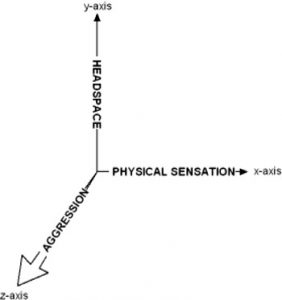
One of the most important aspects of this model is that it explores both continuums of the Dominant/Submissive roles (or title) as well as the Top and Bottom roles. The Dominant and Submissive roles have been categorized within the power area (or title), and do not require any action to be done and is sometimes referred to as their headspace. The Top and Bottom roles have been categorized within the action area and they themselves do not specify who is in the lead position or position of Power. “Perceived” power is used in this model as commonly the Bottoms or Submissive individuals are the ones in the actual power position. They are the ones ultimately setting the boundaries and limits while consenting to the activities or lifestyle.
Interestingly, many individuals within the BDSM community blur the lines between power and action when they refer to a particular label. For example, being called a Top when an individual has not done any identified action may really be only a “Dom” or dominant at that point in time. Although the Top and Dom are generally viewed as aligning together, there is still discussion that the Dom can be the receiver and that the action is differentiated from the power or headspace identified. Again, to help a better understanding, this model is choosing to break these two concepts apart to help better differentiate what and how it is occurring. As a result, this Top label is ultimately based actually on only one of these concepts (position of giver of action). This model helps to add the missing clarity of a title, within these two concepts, which, in actuality, is significantly different (doing something versus relating to someone based on a position of power).
In looking at Figures 1 or 5, placing or categorizing an individual within the Dominant column occurs when they take on the role of exerting a dominant influence or leading the activity. This position is where the individual is in an ascribed “power” position and directs the activities. The placing within the Submissive column occurs when an individual chooses to take on the role of a follower from the lead of the dominant individual. The action rows (both top and bottom) identify the giver/doer or taker/receiver of some form of activity. A Top is defined as the giver of the activity and the Bottom as the receiver.
Intensity of the concepts
To expand this model and relational dynamic more thoroughly, the more intensity or preference polarized the level of activity, the more one will be polarized on the MAPP grid system. For instance, the more polarized left on the map, the more dominant the power position and more polarized right, the more submissive the preference or role. The more polarized up in the grid system, the more the intensity or preference of the giving the person is engaging in, while the more polarized towards the bottom of the grid, the more the intensity or preference for receiving.
How personal labels or titles fit
Beyond the basics of the grid system identified within the MAPP model, common BDSM labels can now be mapped into the model – see Figure 5.
Historically, dominant/top and sadist as well as submissive/bottom and Masochist have been clumped together. This model now separates these identifiers to increase clarity and decrease the clumping through better clarification. For instance, some common titles or labels within the Dominant column are Alpha and Dom(me)/Dominant, Daddy, etc., if they fall within the upper left quadrant (i.e. a Dominant Top) and they are the doer. If a Dominant prefers to be receiving, as opposed to giving/executing the action, at that time they would or could be viewed as a receiving Master or Dominant Bottom. The title of Master or Dom could however fall anywhere on the column, depending on the particular action being performed to whom while still falling under the community’s generally accepted definition(s). There is fluidity in this model and these are just general locations where these would commonly fall. Within the MAPP, these individuals would still be identified under the Dominant column. By doing it this way, this would add the clarity so needed, especially if there is a strong tendency for giving versus receiving by the Dom or Master. Additional terms that fall into this Dominant Bottom category could include “Bossy Bottom” or “Topping from the Bottom.”
The title of “Slave,” especially if they are in a service or giver role (doing something to or for the other party), will more likely fall in the Submissive column, in the top row of the upper right quadrant. A “Service Dom(inant)” may also fall into this category depending on how the power play or action is presented as this title/role could shift quickly (switching between the two). The title of “Prey” would be classified in the bottom right quadrant of this model as an individual’s identity/label. This form of activity will be typically indicating a “desire to be desired,” being “hunted by their partner,” or “consensually taken,” and will be on the receiving and submissive end of the activity usually with the Predator doing what they want within the prey or submissive’s acceptable boundaries.
The grey zone or switching
When one is a “Switch” or engages in switching between top and bottom behavior or dominant and submissive behavior (see Figure 5), this individual would move or could be categorized along the central grid lines of this model, which could be a preference to be in the middle of either the power column or the Action row, or maybe is there just for that action. “Switches,” or individuals engaging in “switching”, can sometimes lead to behavior that vacillates back and forth during an activity and are generally more fluid in their headspace or action style as they may be open to either position at a given time. Again, one’s classification within this model can work for both a particular activity or as a general preference, since some individuals may identify themselves as primarily a Dominant Top, but may not always want to interact in that role.
Effective interactions
Busbee (2008) indicated that the BDSM community exists primarily through its interactions with others. Given this and based on my experience and observation as a clinician and sex therapist providing service over the last 20+ years, it was my view that a better way of helping clients understand these interactional patterns was to show the diagonal relational pattern that is commonly needed for effective interactions to work in these relationship (see arrows within the center). For instance, a Dominant Top works best with a Submissive Bottom and a Submissive Top works best with a Dominant Bottom. A giving “Service Dom” and a receiving Submissive Bottom will tend to move towards the center points of the grid or column in the MAPP, but for it to work effectively it will still need to be diagonal to each other. However, the intensity of the action will determine where they move within the action relative to each other. I have also observed that any other two-person relationship or action tends to counterbalance each other for each action or perceived power position. Interestingly, most individuals intuitively play opposite roles when they interact.
Finally, individuals who are engaging in behavior within the same column or row at the same time tend not to work as well. For instance, it is difficult to have two Dominants leading or two Tops giving at the same time without someone receiving (unless there is a third party involved). Nevertheless, one could have two Switches engaging in the same activity as long as they are giving and receiving the same type of activity at the same time (i.e. both spanking each other simultaneously).
The tilted alpha
Frequently, there may be a need or desire for one party to help shift the balance in their activity by taking on another role temporarily due to their interaction not matching their interactional arousal patterns. For instance, if person A temporarily moves from a position of “Prey” to “Bossy Bottom” (starting at bottom right quadrant moving left) to direct their partner B, who may want to be more assertive for person A, but who is more of a Submissive Top or Service Dom (top right quadrant) and may need to be prompted or supported into the role of Alpha (top right quadrant) to be more directive (as person A desires) before they (person A) consciously moves back to the position of “Prey” (bottom right quadrant) to be hunted. Once this positioning occurs, then person A can take on the role of “Prey” as they desired with person B now taking on an ascribed Alpha role. This common interaction pattern (as seen in my therapy office) has been labelled by myself as the “Tilted Alpha.” This is based on the shape (the Greek letter alpha on its side) that this looks like when drawing the movement process on the model. It also fits that the term “tilting” derived from Cervantes’ Don Quixote where he was jousting at windmills, however, in this case person A is poking or “tilting” person B into a type of alpha position.
These concepts and relational patterns, as mentioned earlier, also relate well to hetero-normative sexual relationships. This pattern is observed as the desiring pursuer pursuing their partner and doing what the pursuer wants within the pursued individual’s acceptable boundaries (Predator/prey pattern). Ultimately, this MAPP model opens up the possibility to help better explain and visually identify, to couples, where they are in their sexual relational dynamic and where they need to move to in order to make their relationship flow better.
Conclusion
Ultimately, this new MAPP model is meant to reconceptualize what has already been started, to a degree by others, as well as expand on the current models by better clarifying and identifying the current label classifications and interactional patterns seen within the BDSM community. All of this under what appears to be common understandings of the two concepts of power and action (physical and relational in the Raymond conceptualization) and physical sensation and the headspace concept within Pendal’s model. This new MAPP model is meant to help support a better understanding of how common personal or relational labels (particularly those within the BDSM community) fit into some level of organization structure to help explain, frame and also identify the interaction/relational patterns and dynamics as they are outlined within the power and action components. Finally, this model is meant to create an opening for new research and discussions in this area. Given this new model, I encourage those involved in this field of work or practice/play in this area to actively be a part of the needed growth in this area. I therefore invite thoughtful discussion and conversation going forward.
Disclosure statement
No potential conflict of interest was reported by the author.
This is an Accepted Manuscript of an article published by Taylor & Francis in Sexual and Relationship Therapy on February 23, 2017, available online: http://www.tandfonline.com/doi/full/10.1080/14681994.2017.1291930.
References
- Busbee, E.R. (2008). Power exchange: Interaction and identity in a BDSM community (doctoral dissertation), available from ProQuest dissertation and theses database. (UMI Number: 3317068) [Google Scholar]
- Crepault, C., & Couture, M. (1980). Men’s erotic fantasies. Archives of Sexual Behavior, 9, 565–581.[CrossRef], [PubMed], [Google Scholar]
- Dawson, S.J., Bannerman, B.A., & Lalumière, M.A. (2014). Paraphilic interests: An examination of sex differences in a nonclinical sample. Sexual Abuse: A Journal of Research and Treatment, 1, 20–45. doi:10.1177/1079063214525645[CrossRef], [Web of Science ®], [Google Scholar]
- Hebert, A., & Weaver, A. (2015). Perks, problems, and the people who play: A qualitative exploration of dominant and submissive BDSM roles. The Canadian Journal of Human Sexuality, 24, 49–62. doi:10.3138/Cjhs.2467.[CrossRef], [Web of Science ®], [Google Scholar]
- Kolmes, K., Stock, W., & Moser, C. (2006). Investigating bias in psychotherapy with BDSM clients. Journal of Homosexuality, 50, 301–324. Retrieved from http://dx.doi.org/10.1300/J082v50n02_15. Medline: 16803769[Taylor & Francis Online], [Web of Science ®], [Google Scholar]
- itman , R. E. (1997). Bondage and Sadomasochism. In Schlessinger, L. M. & revitch, E. (Eds.), Sexual Dynamics of Antisocial Behavior, 2nd edition, (pp 252–270) Springfield, Il, Charles C. Thomas. [Google Scholar]
- Moser, C., & Kleinplatz, P.J. (2006). Introduction: The state of our knowledge on SM. Journal of homosexuality, 50, 1–115.
- Moser, C., & Kleinplatz, P.J. (2007). Themes of SM expression. In D. Langdridge & M. Barker (Eds.) Safe, sane and consensual: Contemporary perspectives on sadomasochism Hampshire, UK Palgrave Macmillan, 55–62. [Google Scholar]
- Pawlowski, W. (2016 , June). 50 Shades of What?! Understanding the sexuality in 50 Shades of Grey. Paper Presented at the AASECT-49th Annual Conference, San Juan. [Google Scholar]
- Pendal, J. (2008). Life after IML-September 2008. Retrieved from http://www.pawscave.dircon.co.uk/IML/being57.htm[Google Scholar]
- Powls, J., & Davies, J. (2012). A descriptive review of research relating to sadomasochism: Considerations for clinical practice. Deviant Behavior, 33(3), 223–234. doi:10.1080/01639625.2011 [CrossRef], [Web of Science ®], [Google Scholar]
- Raymonds (2015, June). BDSM and intimate partner violence training.Referenced from personal discussion with Raymond and Presented by Susan Wright at the AASECT annual conference. Puerto Rico.
- Wismeijer, A.A.J., & van Assen, A.L.M. (2013). Psychological characteristics of BDSM practitioners. Journal of Sexual Medicine, 10, 1943–1952. doi:10.1111/jsm.12192
















